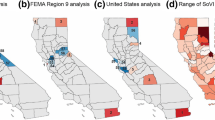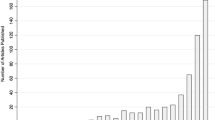Abstract
Social vulnerability indices have emerged over the past decade as quantitative measures of the social dimensions of natural hazards vulnerability. But how reliable are the index rankings? Validation of indices with external reference data has posed a persistent challenge in large part because social vulnerability is multidimensional and not directly observable. This article applies global sensitivity analyses to internally validate the methods used in the most common social vulnerability index designs: deductive, hierarchical, and inductive. Uncertainty analysis is performed to assess the robustness of index ranks when reasonable alternative index configurations are modeled. The hierarchical design was found to be the most accurate, while the inductive model was the most precise. Sensitivity analysis is employed to understand which decisions in the vulnerability index construction process have the greatest influence on the stability of output rankings. The deductive index ranks are found to be the most sensitive to the choice of transformation method, hierarchical models to the selection of weighting scheme, and inductive indices to the indicator set and scale of analysis. Specific recommendations for each stage of index construction are provided so that the next generation of social vulnerability indices can be developed with a greater degree of transparency, robustness, and reliability.





Similar content being viewed by others
References
Aguña, C. G. and M. Kovacevic (2011) Uncertainty and sensitivity analysis of the human development index. United Nations Development Programme, Research Paper 2010/47
Birkmann J (2006a) Indicators and criteria. Measuring vulnerability to natural hazards: towards disaster resilient societies. J. Birkmann. Tokyo: United Nations University Press: 55–77
Birkmann J (2006b) Measuring vulnerability to natural hazards: towards disaster resilient societies. United Nations University Press, Tokyo
Borden KA, Schmidtlein MC, Emrich CT, Piegorsch WW, Cutter SL (2007) Vulnerability of US cities to environmental hazards. J Homel Secur Emerg Manage 4(2):1–21
Burton CG (2010) Social vulnerability and hurricane impact modeling. Nat Hazards Rev 11(2):58–68
Burton C, Cutter SL (2008) Levee failures and social vulnerability in the Sacramento-San Joaquin Delta area, California. Nat Hazards Rev 9(3):136–149
California OES (2010) State of California multi-hazard mitigation plan. Governor’s Office of Emergency Services, Sacramento, CA
Chakraborty J, Tobin GA, Montz BE (2005) Population evacuation: assessing spatial variability in geophysical risk and social vulnerability to natural hazards. Nat Hazards Rev 6(1):23–33
Cherchye L, Lovell K, Moesena W, Puyenbroecka TV (2007) One market, one number? A composite indicator assessment of EU internal market dynamics. Eur Econ Rev 51:749–779
City of Cedar Rapids (2010) Other social effects report: city of Cedar Rapids, Iowa - Flood of 2008. Cedar Rapids
Clark JR, Moul D (2003) Coverage improvement in Census 2000 Enumeration. US Census Bureau, Census 2000 testing, experimentation and evaluation program
Clark G, Moser S, Ratick S, Dow K, Meyer W, Emani S, Jin W, Kasperson J, Kasperson R, Schwarz H (1998) Assessing the vulnerability of coastal communities to extreme storms: the case of revere, MA, USA. Mitig Adapt Strat Glob Change 3(1):59–82
Collins TW, Grineski SE, Aguilar M (2009) Vulnerability to environmental hazards in the Ciudad Juárez (Mexico)-El Paso (USA) metropolis: A model for spatial risk assessment in transnational context. Appl Geogr 29(3):448–461
Cutter SL (1996) Vulnerability to environmental hazards. Prog Hum Geogr 20:529–539
Cutter SL, Mitchell JT, Scott MS (2000) Revealing the vulnerability of people and places: a case study of Georgetown County, South Carolina. Ann As Am Geogr 90(4):713–737
Cutter SL, Boruff BJ, Shirley WL (2003) Social vulnerability to environmental hazards. Soc Sci Q 84(1):242–261
Cutter SL, Burton CG, Emrich CT (2010) Disaster resilience indicators for benchmarking baseline conditions. J Homel Secur Emerg Manage 7:1–24
Damm M (2010) Mapping social-ecological vulnerability to flooding: a sub-national approach for Germany. University of Bonn, PhD Dissertation
de Oliveira Mendes JM (2009) Social vulnerability indexes as planning tools: beyond the preparedness paradigm. J Risk Res 12(1):43–58
DP UN (2004) Reducing disaster risk: a challenge for development. In: Pelling M, Maskrev A, Ruiz P, Hall L (eds) United Nations development programme. Bureau for Crisis Prevention and Recovery, New York
Dunning MC, Durden S (2011) Social vulnerability analysis methods for corps planning. I. f. W. resources. US Army Corps of Engineers, Institute for Water Resources, Washington DC
Dwyer A, Zoppou C, Nielsen O, Day S, Roberts S (2004) Quantifying social vulnerability: a methodology for identifying those at risk to natural hazards. Canberra, Geoscience Australia
Emrich CT (2005) Social vulnerability in US metropolitan areas: improvements in hazard vulnerability assessment. University of South Carolina, PhD Dissertation
EPA (2009) Guidance on the development, evaluation, and application of environmental models. Office of the Science Advisor: Council for Regulatory Environmental Modeling, Washington DC
Esty DC, Levy M, Srebotnjak T, Alexander de Sherbinin (2005). 2005 Environmental Sustainability Index: Benchmarking National Environmental Stewardship. New Haven, Yale Center for Environmental Law & Policy
Fair Data (2003) “Undercount mapper: statistically adjusted PL94 data.” Nationwide dataset of block-level data extracted from the statistically adjusted 2000 census PL94-171 Retrieved April 18, 2009, from http://www.fairdata2000.com/Adjusted/index.html
Fekete A (2009) Validation of a social vulnerability index in context to river-floods in Germany. Nat Hazards Earth Syst Sci 9(2):393–403
Fekete A (2011) Spatial disaster vulnerability and risk assessments: challenges in their quality and acceptance. Natural hazards: 1–18
Finch C, Emrich CT, Cutter SL (2010) Disaster disparities and differential recovery in New Orleans. Popul Environ 31(4):179–202
Flanagan BE, Gregory EW, Hallisey EJ, Heitgerd JL, Lewis B (2011) A social vulnerability index for disaster management. J Homel Secur Emerg Manage 8(1):1–22
Gall M (2007) Indices of social vulnerability to natural hazards: a comparative evaluation. University of South Carolina, PhD Dissertation
Hebb A, Mortsch L (2007) Floods: mapping vulnerability in the upper Thames Watershed under a changing climate. University of Waterloo, Project Report XI, pp 1–53
Holand IS, Lujala P, Rød JK (2011) Social vulnerability assessment for Norway: a quantitative approach. Norsk Geografisk Tidsskrift - Norwegian Journal of Geography 65(1):1–17
HVRI (2008) The SoVI Recipe from http://webra.cas.sc.edu/hvri/docs/SoVIRecipe.pdf
Jones B, Andrey J (2007) Vulnerability index construction: methodological choices and their influence on identifying vulnerable neighborhoods. Int J Emerg Manag 4(2):269–295
JRC (2011) Simlab. Software package for uncertainty and sensitivity analysis. Joint Research Centre of the European Commission, Italy
King D, MacGregor C (2000) Using social indicators to measure community vulnerability to natural hazards. Australian J Emerg Manag 15(3):52–57
Ledesma RD, Valero-Mora P (2007) Determining the number of factors to retain in EFA: an easy-to-use computer program for carrying out parallel analysis. Pract Assess, Res Eval 12(2):1–11
Lein JK, Abel LE (2010) Hazard vulnerability assessment: how well does nature follow our rules? Environ Hazards 9(2):147–166
Mileti D (1999) Disasters by design: A reassessment of natural hazards in the United States. D.C., Joseph Henry Press, Washington
Montz BE, Evans TA (2001) GIS and social vulnerability analysis. Kluwer Academic Publishers, Coping with Flash Floods. E. Gruntfest and J. Handmer. Netherlands, pp 37–48
Mustafa D, Ahmed S, Saroch E, Bell H (2011) Pinning down vulnerability: from narratives to numbers. Disasters 35(1):62–86
Myers CA, Slack T, Singelmann J (2008) Social vulnerability and migration in the wake of disaster: the case of Hurricanes Katrina and Rita. Popul Environ 29(6):271–291
O’Connor BP (2000) SPSS and SAS programs for determining the number of components using parallel analysis and Velicer’s MAP test. Behav Res Methods Instr Comput 32(3):396–402
OECD (2008) Handbook on constructing composite indicators: methodology and user’s guide. Organization for Economic Co-operation and Development, Paris
Parris TM, Kates RW (2003) Characterizing and measuring sustainable development. Annu Rev Environ Resour 28(1):559–586
Passel JS (2005) Estimates of the size and characteristics of the undocumented population. Pew Hispanic Center, Washington, DC
Patil VH, Singh SN, Mishra S, Donavan DT (2007) “Parallel analysis engine to aid in determining the number of factors to retain.” Retrieved January 11, 2011, from http://ires.ku.edu/~smishra/parallelengine.htm
Patil VH, Singh SN, Mishra S, Todd Donavan D (2008) Efficient theory development and factor retention criteria: Abandon the [] eigenvalue greater than one’criterion. J Bus Res 61(2):162–170
Rygel L, O’Sullivan D, Yarnal B (2006) A Method for constructing a social vulnerability index: an application to hurricane storm surges in a developed country. Mitig Adapt Strat Glob Change 11(3):741–764
Saisana M, Saltelli A (2008) Uncertainty and sensitivity analysis of the 2008 environmental performance index. Joint Research Centre of the European Commission, Ispra
Saisana M, Nardo M, Srebotnjak T (2005a) Robustness analysis of the 2005 environmental sustainability index. Joint Research Centre of the European Commission and the Yale Center for Environmental Law and Policy, Ispra
Saisana M, Saltelli A, Tarantola S (2005b) Uncertainty and sensitivity analysis techniques as tools for the quality assessment of composite indicators. J Roy Stat Soc 168(2):307–323
Saltelli A, Tarantola S (2002) On the relative importance of input factors in mathematical models: safety assessment for nuclear waste disposal. J Am Stat As 97(459):702–709
Saltelli A, Ratto M, Andres T, Campolongo F, Cariboni J, Gatelli D, Saisana M, Tarantola S (2008) Global sensitivity analysis: the primer. Wiley, West Sussex
Schmidtlein MC, Deutsch RC, Piegorsch WW, Cutter SL (2008) A sensitivity analysis of the social vulnerability index. Risk Anal 28(4):1099–1114
Schmidtlein MC, Shafer JM, Berry M, Cutter SL (2010) Modeled earthquake losses and social vulnerability in Charleston, South Carolina. Appl Geogr 31(1):269–281
Schneiderbauer S, Ehrlich D (2006) Social levels and hazard (in) dependence in determining vulnerability. In: Birkmann J (ed) Measuring vulnerability to natural hazards: towards disaster resilient societies. United Nations University Press, Tokyo, pp 78–102
Tate E (2011) Indices of social vulnerability to hazards: model uncertainty and sensitivity. Department of Geography, University of South Carolina, PhD Dissertation
Tate E (forthcoming) Uncertainty analysis for a social vulnerability index. Annals of the association of American geographers
Tate E, Cutter SL, Berry M (2010) Integrated multihazard mapping. Environ Plan B: Plan Des 37(4):646–663
UNDP (2010) The real wealth of nations: pathways to human development. Human development report. United Nations Development Programme, New York
Villa F, McLeod H (2002) Environmental vulnerability indicators for environmental planning and decision-making: guidelines and applications. Environ Manage 29(3):335–348
Vincent K (2004) Creating an index of social vulnerability to climate change in Africa. Working paper 56. London: Tyndall Centre for Climate Change Research
Wisner B, Blaikie P, Cannon T, Davis I (2004) At risk: natural hazards. People’s Vulnerability and Disasters, New York, NY, Routledge
Wood NJ, Burton CG, Cutter SL (2010) Community variations in social vulnerability to Cascadia-related tsunamis in the US Pacific Northwest. Nat Hazards 52(2):369–389
Wu SY, Yarnal B, Fisher A (2002) Vulnerability of coastal communities to sea level rise: a case study of Cape May County, New Jersey, USA. Clim Res 22:255–270
Xu C, Gertner GZ (2008) A general first-order global sensitivity analysis method. Reliab Eng Syst Saf 93(7):1060–1071
Acknowledgments
This research was funded by the National Science Foundation, through the Graduate Research Fellowship Program. In addition to the insightful feedback provided by the three anonymous reviewers, I would like to thank Shama Perveen and Tim Frazier, who provided comments on an earlier draft.
Author information
Authors and Affiliations
Corresponding author
Rights and permissions
About this article
Cite this article
Tate, E. Social vulnerability indices: a comparative assessment using uncertainty and sensitivity analysis. Nat Hazards 63, 325–347 (2012). https://doi.org/10.1007/s11069-012-0152-2
Received:
Accepted:
Published:
Issue Date:
DOI: https://doi.org/10.1007/s11069-012-0152-2




